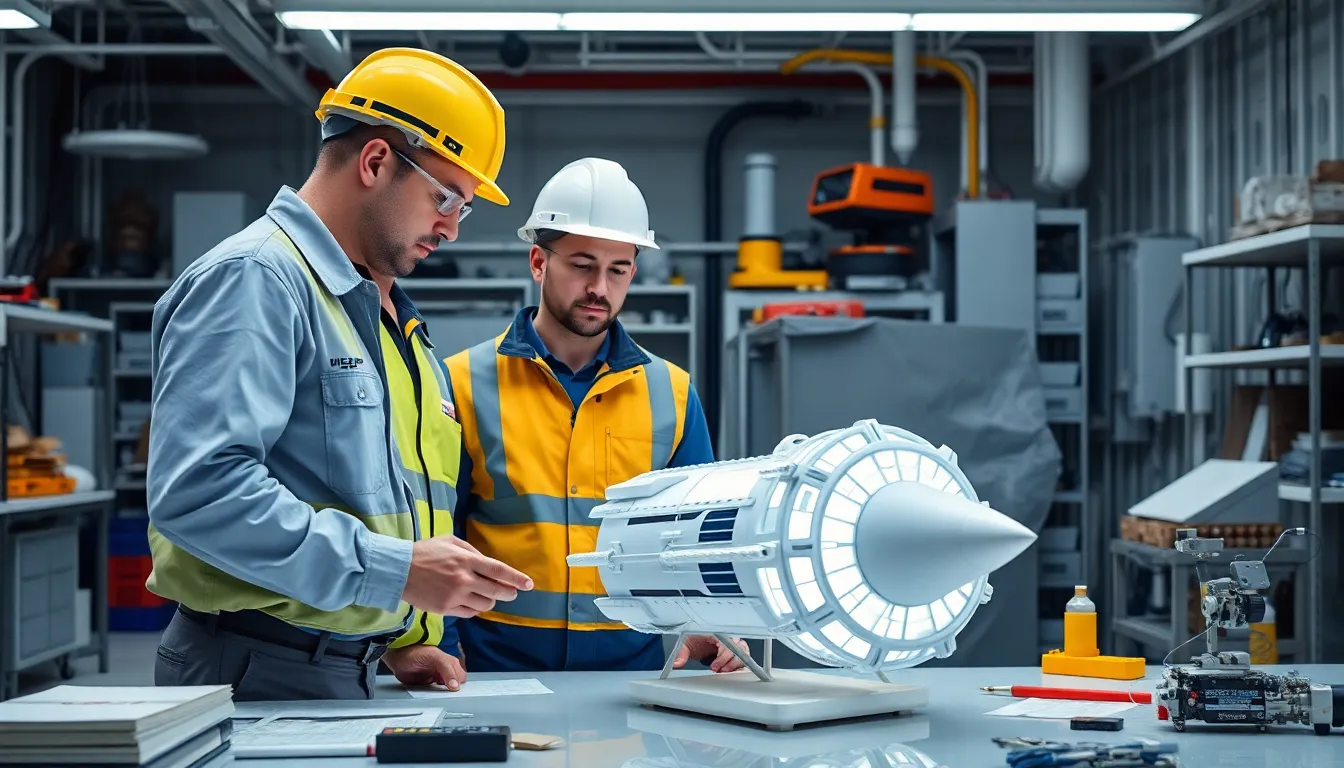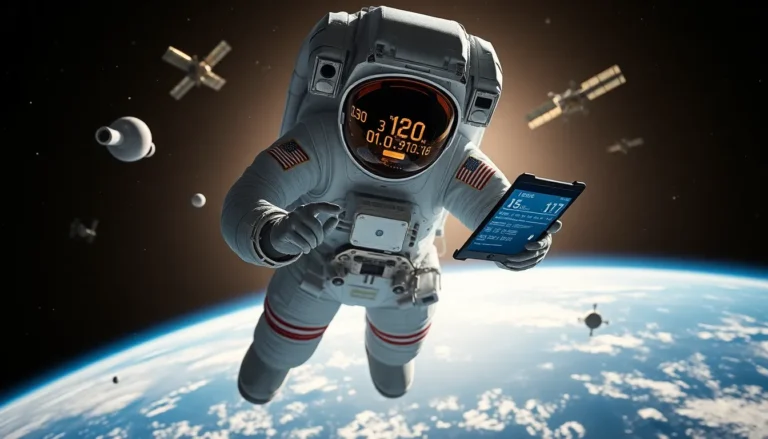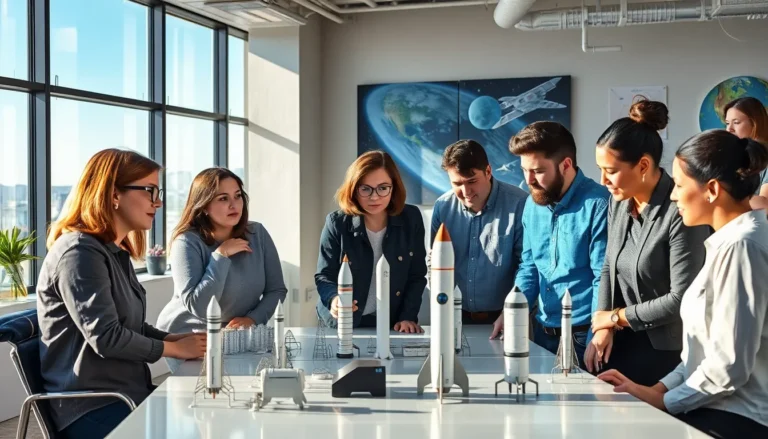Spacecraft design isn’t just about slapping some metal together and hoping for the best. It’s a thrilling blend of artistry and engineering that makes sci-fi dreams a reality. Imagine crafting a vehicle that can withstand the vacuum of space, dodge cosmic debris, and maybe even serve a cup of coffee to astronauts. That’s the magic of it!
Table of Contents
ToggleOverview of Spacecraft Design
Spacecraft design represents a complex interplay of creativity and technical expertise. Engineers and designers tackle challenges like the vacuum of space, extreme temperatures, and radiation. They prioritize functionality, safety, and mission requirements throughout the design phase.
Thermal protection systems offer crucial insulation against temperature fluctuations. Structural integrity ensures that the spacecraft withstands the forces of launch and re-entry. Propulsion systems, from chemical rockets to ion thrusters, play a key role in maneuverability.
Materials selection holds significant importance in spacecraft design. Lightweight composites reduce payload weight, while high-strength alloys enhance durability. Each decision impacts the overall mission success and spacecraft longevity.
Navigation and control systems enable precise trajectories and adjustments during space missions. They incorporate hardware, such as gyroscopes and sensors, for accurate orientation. Software algorithms process data quickly, ensuring real-time responses during critical phases.
User experience also influences design considerations for crewed missions. Comfort, accessibility, and support systems contribute to the astronauts’ well-being. Environmental control systems ensure appropriate levels of air, water, and temperature inside the spacecraft.
Sustainability emerges as a focal point in modern spacecraft design. Designers increasingly explore ways to minimize environmental impact and improve recyclability. Innovations like in-situ resource utilization prioritize efficient resource management for long-duration missions.
Overall, spacecraft design embodies a blend of science, engineering, and imagination. Each element interacts seamlessly, creating a reliable vehicle ready to explore the mysteries of the universe.
Key Principles of Spacecraft Design

Spacecraft design involves critical principles that ensure functionality and safety. Engineers pay attention to various factors that contribute to an effective spacecraft.
Structural Integrity
Structural integrity forms the backbone of spacecraft design. It ensures that the vehicle withstands the intense pressures of launch and space conditions. Designers incorporate high-strength alloys and lightweight composites to achieve the necessary durability while reducing weight. The choice of materials impacts the overall performance and longevity of the spacecraft. Redundant systems often come into play to enhance safety during operations. Testing phases, including simulation and stress tests, identify any vulnerabilities before launch.
Thermal Control
Thermal control plays a significant role in spacecraft design. It protects delicate components from extreme temperature fluctuations encountered in space. Designers utilize thermal protection systems, including insulation materials and radiative heat shields, to manage heat effectively. Depending on the mission, active and passive thermal control methods keep the spacecraft within operational temperature limits. The use of advanced materials enhances these systems’ efficiency. Engineers monitor temperature changes closely to ensure the spacecraft functions optimally.
Propulsion Systems
Propulsion systems drive spacecraft through space, providing necessary thrust for maneuvering. They come in various types, including chemical, electric, and hybrid systems. Chemical propulsion offers high thrust levels suitable for launch, while electric systems provide efficient long-duration travel. Engineers select propulsion technologies based on mission profiles and destination requirements. Assessing fuel efficiency and reliability remains crucial to mission success. Innovations in propulsion continue to evolve, enhancing capabilities for deep-space exploration.
Design Phases in Spacecraft Development
Spacecraft development involves several critical design phases, each contributing to the vehicle’s overall performance and reliability. Each phase organizes the creative processes into manageable steps.
Conceptual Design
Conceptual design identifies mission objectives and outlines the basic spacecraft features. Engineers create preliminary models to visualize design concepts. During this stage, considerations for size, shape, and payload capacity emerge. Team brainstorming sessions often generate innovative ideas. Evaluating various mission profiles provides insight on necessary technologies. Stakeholders engage to ensure alignment with mission requirements and budget constraints.
Preliminary Design
Preliminary design focuses on refining concepts into workable designs. Detailed analysis of subsystems such as thermal management and power distribution takes place. Engineers conduct feasibility studies to confirm design choices support mission goals. A systems integration approach helps anticipate potential challenges. Materials selection becomes critical, prioritizing lightweight and durable options. Mock-ups and simulations illustrate expected performance in space conditions.
Detailed Design
Detailed design translates refined concepts into actionable specifications. Engineers produce extensive documentation covering every aspect of the spacecraft. Each component undergoes rigorous testing to ensure compatibility and functionality. Design validation through simulations confirms adherence to safety standards. Additionally, all systems integration is finalized, readying the spacecraft for production. Quality control measures guarantee that specifications meet organizational benchmarks.
Challenges in Spacecraft Design
Spacecraft design presents significant challenges that require innovative solutions. Engineers face multiple hurdles while ensuring mission success amid various constraints.
Weight Constraints
Weight constraints heavily influence spacecraft design, as every gram impacts launch costs and fuel efficiency. Engineers prioritize lightweight materials, such as carbon fiber composites and aluminum alloys, to reduce overall mass. Balancing structural integrity and weight proves essential; a robust design must withstand launch forces without adding unnecessary bulk. Innovations in miniaturization further contribute to lighter systems, enhancing performance. Ultimately, managing weight effectively can lead to successful missions and more efficient use of resources.
Cost Management
Cost management plays a pivotal role in spacecraft development, where budgets can swiftly escalate. Budget constraints necessitate meticulous planning and prioritization of essential components. Engineers often adopt modular designs, allowing for interchangeable parts that reduce manufacturing expenses. Seeking cost-effective materials and processes becomes standard practice. Collaboration with private industry and government organizations can also provide funding opportunities, enhancing project viability. By effectively managing costs, teams can focus on innovative solutions without compromising mission goals.
Environmental Factors
Environmental factors significantly affect spacecraft design, as engineers must consider varying conditions in space. Temperature extremes can impact material performance, necessitating advanced thermal protection systems to safeguard sensitive components. Radiation exposure poses another challenge, requiring careful selection of materials and shielding strategies. Designers also address microgravity effects during crewed missions to ensure astronaut safety and comfort. These considerations are integral to achieving a sustainable design that anticipates environmental challenges.
Future Trends in Spacecraft Design
Spacecraft design will see substantial advancements driven by innovative materials and autonomous systems. With a focus on performance and sustainability, future designs prioritize efficiency and effectiveness.
Innovative Materials
Engineers increasingly utilize lightweight composites in spacecraft design. These materials reduce overall weight while maintaining strength, contributing to better fuel efficiency. Advanced alloys provide improved durability against harsh space conditions. Another important development involves self-healing materials that can repair minor damages. Such innovations enhance the lifespan and reliability of spacecraft. The integration of nanotechnology further pushes the boundaries by enabling enhanced thermal properties and radiation resistance.
Autonomous Systems
Autonomous systems are transforming mission capabilities in spacecraft design. These systems significantly improve navigation and operational efficiency during missions. Advanced algorithms enable real-time decision-making, reducing reliance on ground control. Robots equipped with artificial intelligence perform maintenance tasks, ensuring safety and functionality. Improved sensor technology allows spacecraft to adapt to dynamic environments, enhancing exploration efforts. By employing these autonomous systems, missions can operate with higher precision and reduced risk for astronauts.
Spacecraft design represents a remarkable fusion of creativity and technical prowess. The challenges faced in developing vehicles for the harsh realities of space demand innovative solutions and meticulous planning. As engineers continue to push the boundaries of materials and technologies, the future of space exploration looks promising.
The emphasis on sustainability and user experience will shape the next generation of spacecraft. With advancements in autonomous systems and smart materials, missions will become more efficient and adaptable. This dynamic field will not only enhance our understanding of the universe but also inspire future generations to dream big and explore beyond the stars.





